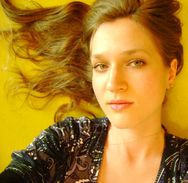Van Mozart tot Rachmaninoff: Maria Prokofieva – piano
8 februari 2015 | 16.45 uur
| Museum Geelvinck Hinlopen Huis,

Programma:
– W.A. Mozart (1756-1791) – Sonate in E flat Major KV282
Adagio
Menuetto I-II
Allegro
– F. Chopin (1810-1849): Scherzo nr. 1, Op. 20
—————– pauze ——————–
– Johannes Brahms (1833-1893) – Klavierstücke Op.118 & Balladen Op.10
– Sergey Rachmaninoff (1873-1943) – Variations on the Corelli theme, Op 42
Maria schrijft over haar programma voor 8 februari:
Mozart piano Sonata n. 4 in E flat major, K 282, in 3 movements:
Starting unusually, with the slow movement in place of fast Allegro, this Sonata is full of light and intimacy. All slow movements for Mozart, on my opinion, are sort of revelation, his fleeting sadness coupled with eternal joy. The menuetto continues the line of the first movement. We can often hear dialogues between voices, reminding us of his great opera duo’s. The last movement – Allegro – is a happy play, like a children game.
Brahms – 2 Klavierstücke Op. 118, n. 2 en n. 5
Klavierstücke Op 118, by Brahms is the most famous and most played (and probably the most loved too! – according to youtube) set of Brahms pieces. And it is for a good reason – all the pieces in the set are very different by character and moods: broad, spacious Intermezzo n.1; intimate Intermezzo n. 2; decisive and energetic Ballade n. 3; hesitant, anxious Intermezzo n. 4; narrative and dreamy Romance n. 5; very sad and deep by emotions last Intermezzo n. 6.
Chopin – Scherzo n.1 Op. 20
This furious Scherzo reflects happenings of the time it was written – a war between Poland and Russia, sounds of fight, chaos and disaster. The contrary middle part is a national Polish Christmas song, a lullaby of Chopin, which reminded him of his childhood.
Brahms – 2 Balladen Op.10 – n.1 en n.4
The first Ballade is written on a Scottish ballade “Edward”, and all 4 pieces in this opus are telling us old stories.
Rachmaninoff – Variations on the Corelli theme, Op. 42
Corelli variations are one of the latest Rachmaninoff’s piece. His musical language, the harmonies are sounding often like modern. It has an ascetic beginning, mystic, furious, march variations, lyrical and major middle part.
Very dramatic, mystic and full of passion variations. It was written on a theme which is originally an old Spanish theme of Follia, about love of a young girl to a priest.
Instrument:
Maria Prokofeva speelt op de Steinweg Nachf. vleugel 1880
Maria Prokofieva was born in Minsk, Belarus. She began her musical education at the age of 5 and one year later already had her first stage experience at the large hall of the Byelorussian State Philharmonic.
At 6 she entered a specialized music school founded by the Byelorussian State Conservatory in Minsk for gifted children (nowadays the school possesses the status of Republican Gymnasium – College under the Byelorussian State Academy of Music) where she studied with Irina Semenyako, Elena Serdyukova, Vera Logvinenko and Alla Himchenko. In 1999 she received her Diploma for Piano Performance and accompaniment with distinction.
The same year Maria was admitted to the Byelorussian State Academy of Music without entrance exams. Her teachers at the Academy were Valery Shatsky (former student of Jacob Flier) – for piano, Sofia Okolova – for accompaniment and Irina Galochkina – for chamber music. In 2004 Maria received her Bachelor of Arts diploma as well as a Diploma of Piano Performance with distinction in four qualifications: concert performer, accompanist, chamber music soloist, teacher.
Afterwards she continued to study at the Byelorussian Academy of music as a post-graduate student and assistant to professor Valery Shatsky for piano performance and pedagogy and Sofia Okolova for accompaniment.
In 2005-2006 Maria was teaching at the Byelorussian Academy of Music at the piano accompaniment department.
In 2006 she was admitted to a Post-graduate course at the Queen Elisabeth College of Music (Belgium) with Abdel Rahman El Bacha.
The next year Maria moved to The Netherlands to study at the Conservatory of Amsterdam. In 2010 she received her Master of Music degree with Naum Grubert.
Maria participated in numerous masterclasses – with Evgeni Koroliov and Willem Brons in 2010, Vladimir Tropp in 2008, Leonid Margarius, Cecile Ousset, Anne Queffelec in 2007, Diane Andersen, Luiz de Moura Castro in 2005, Boyan Vodenitcharov and Daniel Blumenthal in 2004.
She became a laureate and prize-winner at several International piano competitions: Emmanuel Durlet International Piano Competition, Belgium (2005, Laureate), Andre Dumortier International Piano Competition, Belgium (2005, finalist and prize-winner), European Young Soloists Competition, Luxembourg (2003, Gold medal and special prize of jury), Carlo Soliva International Piano Competition, Italy (2000, Finalist), France Music Competition (1999, prize-winner), Oginsky International Competition, Belarus (1995, Laureate).
Maria has performed many concerts at the Byelorussian State Philharmonic, Byelorussian Composers Union, Byelorussian Academy of Music, at different stages in various cities of the Republic of Belarus, in Belgium and France. She also played as a member of chamber music groups in Italy and Germany. As a soloist she performed on the Byelorussian and Belgian radio and television.
Maria often gives recitals and chamber music concerts in The Netherlands, Belgium and France.

